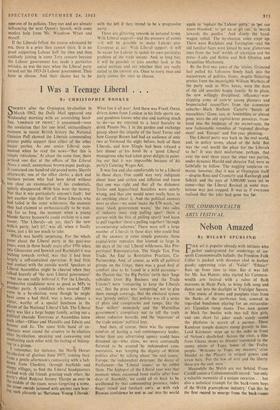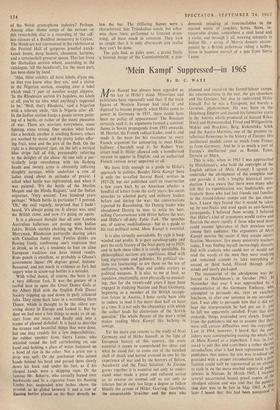THE COMMONWEALTH ARTS FESTIVAL
Nelson Amazed
By HILARY SPURLING
Fotx art is popular already with initiates who gather underground for renderings of un- spoilt Commonwealth ballads; the Freedom Folk Cellar is packed with devotees clad in leather goods; approving cries of `Valid I "Ethnic ' float up from time to time. But it was left for Mr. Ian Hunter. who started his Common- wealth arts festival with a salvo of flash maroons in Hyde Park, to bring folk song and dance out into the daylight in Trafalgar Square.
The music of drums and panpipes rises from the flanks of the north-east lion, covered in toga-clad bandsmen playing for an extraordin- ary Ugandan rump dance. Two men quiver in black fur bustles with two tall thin girls, and one short fat joker scuds vainly round the platform in search of a partner. Three Kandyan temple dancers stamp gravely in line. Lord Kitchener steps up to the mike in front of Nelson's death-bed. Across the river, a film from Ghana shows us Hamlet translated to the sunny plains of Togo, home of the Frafra people. 'Welcome to Togo. my _masters,' cries Hamlet to the Players in striped gowns and straw hats. 'For the law of writ and the liberty these are the only men.'
Meanwhile the Welsh are not behind. From Cardiff comes a Commonwealth record: 'not only a valuable memento of a unique occasion ... but also a technical triumph for the back-room boys of the Welsh gramophone industry.' Can this be the first record to emerge from the back-rooms
of the Welsh gramophone industry? Perhaps. Among other theme songs of the nations on this remarkable disc is a recording of 'the self- less silences of a Buddhist monastery in Ceylon.' The Welsh are not represented in the exhibition at the Festival Hall of gorgeous jewelled knick- knack boxes, dung baskets, chessmen, hairpins, and a tortoiseshell preserve spoon. This last from the Barbadian section where, according to the catalogue, `all the handicraft, for the most part, has been done by hand.'
`Aha, these exhibits all have labels, d'you see, so that you know what they are,' said a visitor in the Nigerian section, stooping over a label which read 'I pair of woollen wuppi slippers.' 'In the Rhodesian section it's hopeless, no labels at all, you've no idea what anything's supposed to be."Well, that's Rhodesia,' said a Nigerian with a tolerant smile, 'this is Nigeria after all.' In the Indian section hangs a gaudy screen paint- ing of a battle, or rather of the many pleasures of war. There are warriors everywhere, some fighting, some resting. One smokes what looks like a hookah, another is smelling flowers, others are soothed by music and by pretty ladies offer- ing fruit, wine and the joys of the flesh. On the right is a decapitated tiger, on the left a vertical blue stripe full of fish, presumably referring to the delights of the chase. At one side a par- ticularly large swordsman with ten flashing heads and twenty arms is obviously inflicting doughty carnage, while underfoot a row of ladies stanil about in attitudes of prayer. I asked what battle was represented, and when it was painted. 'It's the battle of the Muslim Moguls and the Hindu Rajputs,' said the Indian organiser. 'Very ancient, Two hundred years perhaps.' Which battle in particular?' I pressed. 'Oh,' she said vaguely, surprised that I hadn't heard, 'it's always going on. It always was, until the British came, and now it's going on again.'
It is a pleasant thought that all over London Australian ballerinas are posing with Indian fakirs, British starlets chatting up West Indian Merrymen, Rhodesian patriarchs sharing jokes with Canadian funny men. Festive drinks are flowing freely, confirming one's suspicion that in drink, as in art, a tendency -to lean on alien European tradition can have mixed results. Rum punch is excellent, so probably is Ghana's government liquor (90 degrees proof, banana- flavoured, and not much in evidence so far), but sugary wine in screw-top bottles is a mistake.
With tribal dance, of course, the boot is on a very different foot. It was the gesture of a tactful host to open the Great Dance Gala at the Albert Hall with the English Folk Dance Society tripping up and down in gaily coloured felts. They came back later in a wambling Horn Dance, which is thought to be the oldest sur- viving dance in Europe and looked it. But by then we had seen a few things to make us sit up, start from our seats, and finally sink into a trance of pleased disbelief. It is hard to describe the strange and beautiful things that were done, but one may crudely list a few impossibilities: the rubber tumbler from Sierra Leone, who whistled round the hall cartwheeling on one hand and holding a glass of water balanced on a bowl of rice in the other. Not a grain nor a drop was spilt. Or the gentleman who joined hands behind his head and passed them slowly down his back and under his feet, as if his clasped hands were a skipping rope. Or the famous Mr. Beharry, who casually leaned over backwards and lit a cigarette from his flaming Limbo bar, suspended nine inches above the ground, as he glided between it and a row of flaming bottles placed on the floor directly be-
low the bar. The titillating flames were a characteristic late Trinidadian touch, but other. wise these feats, performed to frenzied drum- ming, all have much in common. They look so simple that it is only afterwards you realise they can't be done.
The gala had, as galas must, a grand finale, a fevered image of the Comnionwtalth, a pan. demonic mingling of irreconcilables to the massed music of conches, horns, flutes, in- numerable drums, somewhere a steel band and a violin, and through it all, weaving solemnly in Indian file, a string of Morris dancers accom- panied by a British policeman riding a hobby- horse in hopeless pursuit of a juju from Sierra Leone.



































 Previous page
Previous page